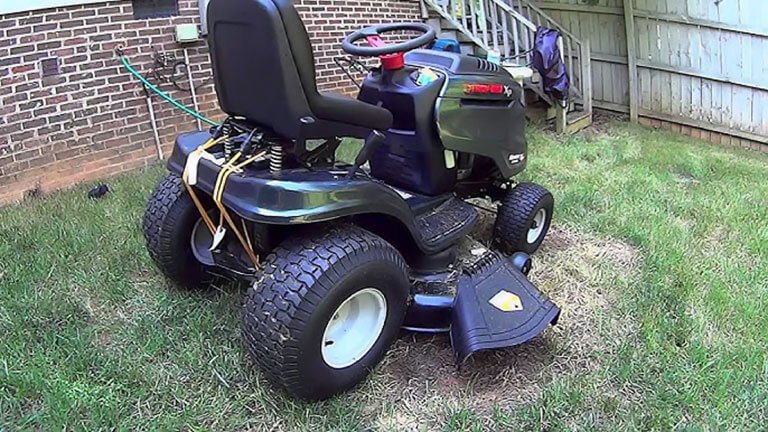Hydrostatic Lawn Mower Transmission Problems: Quick Fixes
Hydrostatic lawn mower transmission problems often stem from low fluid levels or air in the system. Regular maintenance and timely troubleshooting can resolve these issues effectively.
Hydrostatic transmissions provide seamless operation for lawn mowers, offering an easy driving experience. These systems use hydraulic fluid to transfer power, making them popular among homeowners and landscapers alike. However, like any mechanical system, hydrostatic transmissions can encounter issues that affect performance.
Understanding common problems, such as loss of power or strange noises, is crucial for timely repairs. Regular maintenance, including checking fluid levels and inspecting hoses, can significantly extend the life of the transmission. This guide will help you identify potential hydrostatic lawn mower transmission problems and offer solutions to keep your mower running smoothly.
Introduction To Hydrostatic Lawn Mower Transmissions

Hydrostatic lawn mower transmissions play a vital role in how mowers operate. They provide smooth and efficient power to the wheels. Understanding hydrostatic technology helps users maintain their mowers effectively.
Basics Of Hydrostatic Technology
Hydrostatic technology uses fluid to transmit power. Here are the key components:
- Hydraulic Fluid: This fluid transfers energy.
- Pump: It creates pressure to move the fluid.
- Motor: Converts fluid pressure into mechanical power.
This system allows for variable speed control. Operators can adjust the speed easily. No gears are needed, making it simpler to operate.
Benefits For Lawn Mowing
Hydrostatic transmissions offer several advantages for lawn mowing:
- Smooth Operation: Provides a seamless cutting experience.
- Easy Control: Simple to speed up or slow down.
- Less Wear: Reduces strain on components, leading to longer life.
- Better Maneuverability: Ideal for complex yard layouts.
These benefits make hydrostatic mowers popular among homeowners and professionals. Understanding these features enhances lawn care routines.
Common Issues With Hydrostatic Transmissions
Hydrostatic transmissions are popular in lawn mowers. They offer smooth operation and easy control. However, they can face problems over time. Understanding these issues helps in timely repairs.
Lack Of Response
A common issue is the lack of response from the mower. This can happen for several reasons:
- Low fluid levels
- Air in the system
- Worn-out components
Check the fluid levels regularly. Low fluid can cause sluggish movement. Air in the system can lead to delays in response. Inspect the components for wear and tear. Replacing worn parts can restore performance.
Strange Noises During Operation
Unusual noises can indicate problems. Listen for these sounds:
- Grinding noises
- Hissing sounds
- Clunking noises
Grinding noises often signal worn gears. Hissing sounds may come from leaking fluid. Clunking noises can indicate loose parts. Addressing these issues early prevents further damage.
Overheating Problems
Overheating is another serious concern. It can cause significant damage. Here are common causes:
- Low fluid levels
- Dirty filters
- Blocked cooling fins
Check the fluid levels regularly. Clean or replace dirty filters. Ensure the cooling fins are clear. Overheating can lead to costly repairs. Regular maintenance avoids these issues.
Initial Diagnostic Steps
Hydrostatic lawn mower transmission problems can be frustrating. Quick diagnostics can save time and effort. Start by following these initial steps to identify the issue.
Checking The Fluid Level
Fluid levels play a crucial role in the performance of hydrostatic transmissions. Low fluid can lead to poor operation. Here’s how to check the fluid level:
- Park the mower on a flat surface.
- Locate the fluid reservoir. It’s usually near the transmission.
- Remove the dipstick and wipe it clean.
- Reinsert the dipstick without screwing it in.
- Check the fluid level against the markers on the dipstick.
Tip: Always use the recommended fluid type for your mower.
Inspecting For Leaks
Leaks can cause significant issues. They may indicate a problem with seals or hoses. Follow these steps to inspect for leaks:
- Look under the mower for puddles or stains.
- Inspect hoses for cracks or wear.
- Check seals around the transmission for damage.
- Examine the fluid reservoir for cracks or leaks.
Warning: Operating with leaks can damage other components.
Assessing Belt Condition
The drive belt connects the engine to the transmission. A worn or damaged belt affects performance. To assess the belt condition:
- Turn off the mower and disconnect the battery.
- Remove the belt cover for easy access.
- Inspect the belt for cracks, fraying, or slack.
- Check for proper alignment on pulleys.
Replace the belt if you notice any issues.
Quick Fixes To Try
Hydrostatic lawn mowers are efficient machines. They can face transmission problems. Quick fixes can help restore their performance. Here are some simple solutions to consider.
Changing The Transmission Fluid
Old or dirty fluid can cause issues. Follow these steps to change the fluid:
- Gather supplies: new transmission fluid, a funnel, and a container.
- Locate the fluid reservoir on your mower.
- Drain the old fluid into the container.
- Use the funnel to add new fluid.
- Check the fluid level using the dipstick.
Changing the fluid can improve performance. Make this a regular part of maintenance.
Bleeding Air From The System
Air in the system can lead to problems. Bleeding the system helps restore proper function:
- Start the mower and let it run.
- Locate the bleed valve, usually on the pump.
- Open the valve slowly.
- Watch for fluid to come out, indicating air is escaping.
- Close the valve once fluid flows steadily.
Bleeding air can improve the mower’s responsiveness. Check for any leaks afterward.
Adjusting The Belt Tension
Loose belts can affect transmission. Adjusting the tension is a simple fix:
| Step | Action |
|---|---|
| 1 | Turn off the mower and disconnect the battery. |
| 2 | Locate the belt tension adjustment area. |
| 3 | Loosen the adjustment bolts. |
| 4 | Adjust the tension until the belt is snug. |
| 5 | Tighten the bolts securely. |
Proper belt tension helps ensure smooth operation. Regular checks can prevent future issues.
Troubleshooting Transmission Slippage
Hydrostatic lawn mower transmission slippage can be frustrating. It affects performance and efficiency. Identifying the issue early saves time and money. Here’s how to troubleshoot slippage effectively.
Identifying Slippage Symptoms
Recognizing the signs of transmission slippage is crucial. Look for these symptoms:
- Unresponsive Acceleration: The mower does not speed up.
- Inconsistent Speeds: The mower speeds up and slows down unexpectedly.
- Strange Noises: Listen for grinding or whining sounds.
- Difficulty in Steering: The mower feels hard to control.
Documenting these symptoms helps in diagnosing the issue. Check the owner’s manual for specific indicators.
Correcting Pulley Issues
Pulleys play a vital role in the transmission system. Issues with them can cause slippage. Follow these steps to check and correct pulley problems:
- Inspect the drive belt for wear or damage.
- Ensure the pulleys are aligned properly.
- Check for looseness in the pulley connections.
- Lubricate the pulleys to ensure smooth operation.
Replacing a worn drive belt can prevent slippage. Ensure belts fit tightly and are in good condition.
Replacing Worn Components
Worn components often lead to slippage issues. Common parts to check include:
| Component | Signs of Wear | Replacement Tips |
|---|---|---|
| Drive Belt | Cracks or fraying | Use OEM parts for best fit. |
| Hydrostatic Fluid | Dark color or burnt smell | Change fluid regularly. |
| Filter | Clogged or dirty | Replace as per schedule. |
Regular maintenance prevents issues. Inspect and replace worn parts promptly. This keeps your mower running smoothly.
Addressing Overheating Issues
Overheating is a common problem in hydrostatic lawn mower transmissions. High temperatures can damage components and reduce performance. Identifying and resolving these issues is crucial for maintaining your mower.
Improving Air Circulation
Good airflow helps keep your mower cool. Here are some ways to improve air circulation:
- Remove grass clippings and debris from the mower.
- Check the air intake and exhaust vents. Ensure they are clear.
- Inspect the fan for any obstructions or damage.
Upgrading The Cooling System
Sometimes, an upgrade is needed for better cooling. Consider these options:
| Upgrade Option | Benefits |
|---|---|
| High-Performance Radiator | Increased cooling efficiency |
| Enhanced Cooling Fan | Better airflow and lower temperatures |
| Cooling Fluid Additives | Improved heat dissipation |
Regular Maintenance Tips
Maintaining your mower can prevent overheating. Follow these tips:
- Change the oil regularly.
- Check the hydraulic fluid levels.
- Inspect belts and hoses for wear.
- Clean air filters often.
- Schedule professional inspections annually.
Taking these steps helps ensure your hydrostatic lawn mower runs smoothly.
Dealing With Strange Noises
Strange noises from your hydrostatic lawn mower can be alarming. These sounds may indicate underlying problems. Identifying the noise early can save time and money. Understanding where the noise comes from is crucial.
Isolating The Noise Source
First, locate the source of the noise. Here are steps to help you:
- Start the mower and listen carefully.
- Identify if the noise is coming from:
- The engine
- The transmission
- The blades
- The wheels
- Move closer to pinpoint the area.
Different noises can signal various issues. For example:
| Noise Type | Possible Cause |
|---|---|
| Grinding | Worn-out gears or bearings |
| Clicking | Loose parts or debris |
| Humming | Hydraulic fluid issues |
Fixes For Common Noisy Components
Addressing the noise can often be simple. Here are common fixes:
- Engine Noises: Check the oil level. Change oil if needed.
- Transmission Noises: Inspect hydraulic fluid. Replace if dirty.
- Blade Noises: Sharpen or replace dull blades.
- Wheel Noises: Tighten loose bolts.
Regular maintenance helps prevent these issues. Clean your mower after use. Check for debris that may cause noise.
When To Seek Professional Help
Some noises require expert attention. Seek help in these cases:
- Unusual sounds persist after basic fixes.
- Hydraulic issues are complex.
- Mechanical parts are damaged.
Professional mechanics can diagnose tricky problems. They have specialized tools and knowledge. Don’t hesitate to ask for help.
Preventative Measures For Long-term Care
Hydrostatic lawn mowers offer ease and efficiency. However, they can face transmission issues. Preventative measures help ensure smooth operation. Regular care keeps your mower running longer.
Scheduled Maintenance Routines
Establish a consistent maintenance schedule. Regular check-ups will help spot issues early. Follow these steps:
- Check fluid levels monthly.
- Inspect belts and hoses every season.
- Change hydraulic fluid as recommended.
- Clean air filters regularly.
Use the manufacturer’s guidelines. This ensures you perform the right maintenance. Keep records of all maintenance done.
Best Practices For Transmission Health
Proper usage can extend the life of your mower. Follow these best practices:
- Do not overload the mower.
- Avoid steep slopes during operation.
- Allow the mower to cool before servicing.
- Use the correct fuel type.
Monitor transmission performance. Listen for unusual noises. These signs can indicate problems.
Understanding When To Replace
Knowing when to replace parts is essential. Look for these indicators:
| Signs of Wear | Action Needed |
|---|---|
| Fluid leaks | Check seals and gaskets |
| Sluggish movement | Inspect hydraulic fluid levels |
| Unusual noises | Examine transmission components |
Replace worn parts immediately. This prevents further damage. Timely actions save time and money.
Conclusion: Ensuring Optimal Performance
Hydrostatic lawn mowers require care for top performance. Addressing issues quickly helps maintain efficiency. Regular maintenance prevents costly repairs and extends lifespan.
Summary Of Quick Fixes
Here are some quick solutions to common problems:
- Check Fluid Levels: Ensure hydraulic fluid is at the right level.
- Inspect Hoses: Look for cracks or leaks in hoses.
- Clean Filters: Dirty filters can hinder performance. Clean or replace them.
- Tighten Belts: Loose belts can cause slipping. Tighten them as needed.
The Importance Of Regular Check-ups
Regular check-ups keep your mower running smoothly. Schedule maintenance at least twice a year. Here are key aspects to check:
- Fluid levels and quality
- Belts and hoses for wear
- Battery condition
- Blade sharpness
Keeping a maintenance log helps track performance. Document repairs and service dates. This history aids in identifying recurring issues.
Knowing Your Mower’s Limitations
Every mower has limitations. Understand these to avoid problems. Here are some factors to consider:
| Factor | Limitation |
|---|---|
| Terrain Type | Avoid steep hills or rough ground. |
| Load Capacity | Do not exceed weight limits. |
| Speed Settings | Higher speeds may cause strain. |
Recognizing these limits helps prevent breakdowns. Proper use ensures longevity and reliability.
Frequently Asked Questions
What Are Common Hydrostatic Transmission Issues?
Common issues include fluid leaks, slipping, and unusual noises during operation, affecting mower performance.
How Can I Troubleshoot My Mower’s Transmission?
Check fluid levels, inspect hoses for leaks, and listen for irregular sounds to identify potential problems.
Why Is My Mower Losing Power?
Power loss may result from low hydraulic fluid, clogged filters, or worn components within the transmission system.
How Do I Maintain Hydrostatic Transmission?
Regularly check fluid levels, replace filters, and ensure connections are tight to maintain optimal performance.
Can I Fix Transmission Problems Myself?
Many minor issues can be fixed at home, but complex problems may require professional assistance for safety.
Conclusion
Hydrostatic lawn mower transmission issues can disrupt your mowing routine. Regular maintenance helps prevent these problems. Pay attention to signs like unusual noises or sluggish movement. Addressing these concerns early can save you time and money. Stay proactive, and your mower will serve you well for years to come.
Happy mowing!






